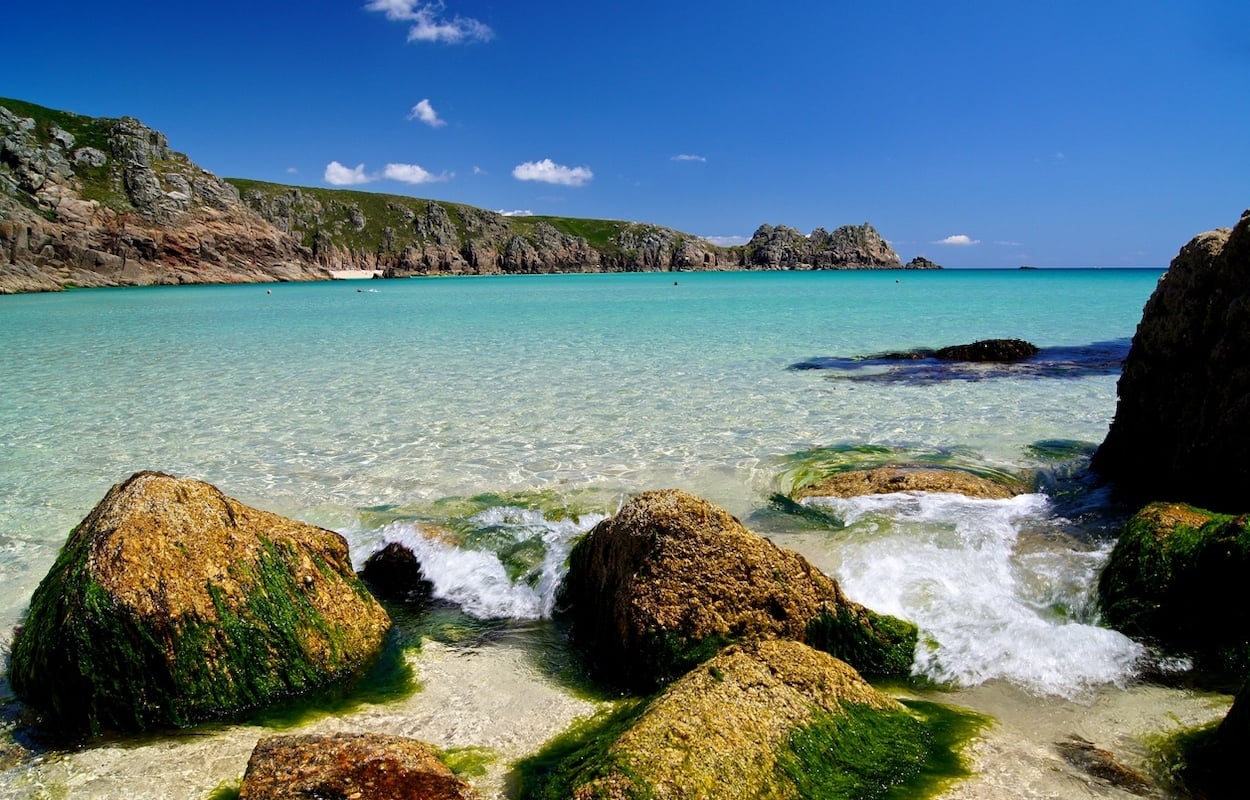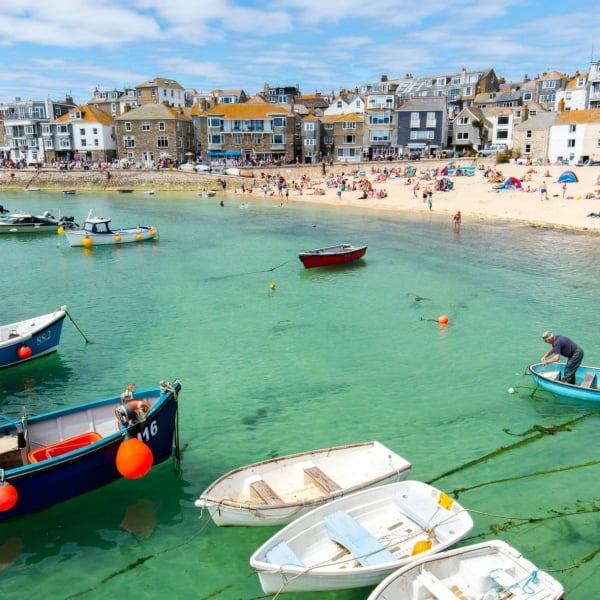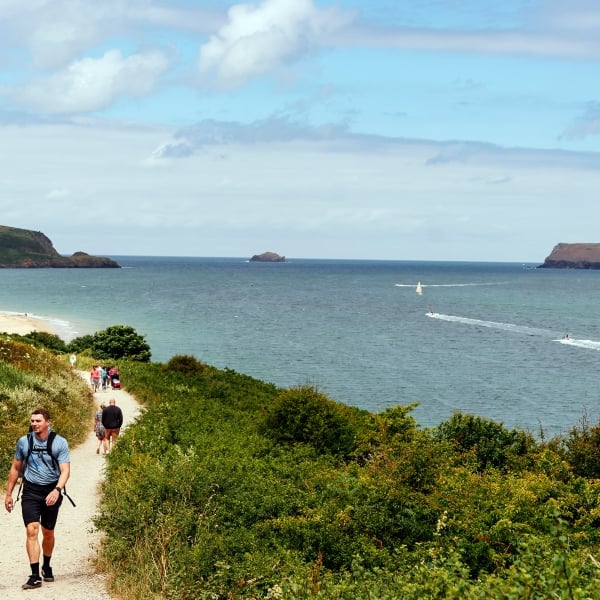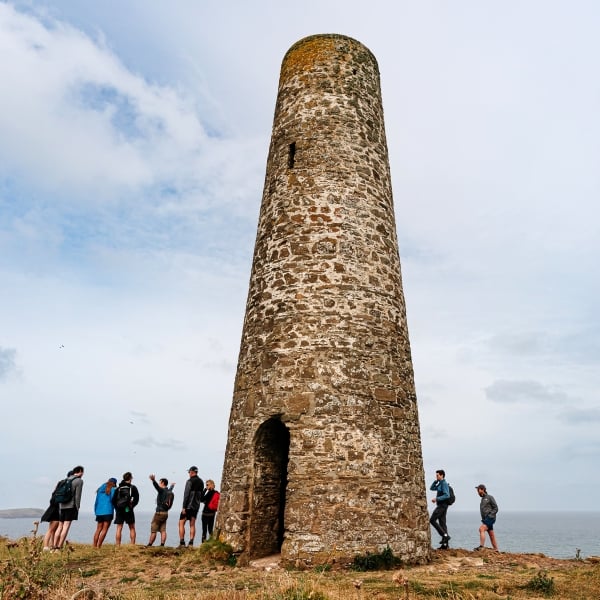The magnificent coastal scenery along England’s Cornwall peninsula has been drawing artists, poets, and beach lovers to the region for centuries—but few can say they truly understand its diverse landscape and culture. “I’m actually from a small Cornish village on the South Coast,” says Gaby Cecil, a close Country Walkers friend who helped design this unique walking adventure. “We planned this Cornwall experience to help our guests understand the beauty of the region the way the locals do.” On the Country Walkers England: Cornwall & the South West Coast Path Guided Tour, you’ll take a deep dive into Cornish culture—starting with the rugged northern shore of Cornwall with its thundering Atlantic coast, then head south for a taste of sheltered coves with aquamarine beaches and lush, enchanted forests. This is the authentic Cornwall!
Mermaids and Mariners in Cornwall’s Wild North
England’s famous South-West Coast Path traces the shores of Cornwall and includes some of the United Kingdom’s most spectacular coastal scenery. As your local English trip leaders guide you along the rugged trails of Cornwall’s North Coast, they’ll stop to point out ancient churches and crumbling watchtowers—as well as the best spots to photograph dramatic cliffs tumbling into the azure Atlantic. “The North Coast is very open to the elements, and there’s a sense of wilderness along the rocky coastline,” says Gaby. “Our walks on the northern coast feel a little more wild than those in the south.” In charming fishing villages along the way, your local trip leaders will steer you towards the best seaside cafés where you can enjoy the day’s fresh catch, or cozy tearooms where you can partake in a traditional Cornish cream tea (jam first!)
In the charming village of Padstow, your harborside hotel is perched on the banks of the Camel Estuary. As you gaze at the harbor, you may notice an unusual sandbar—and in its origins, lies a local legend. The mouth of Cornwall’s River Camel was once deep and clear—navigable by ships both large and small. The passage was tricky, but the Cornishfolk had made an alliance with a lovely mermaid who guided ships through the estuary’s narrow waters. One day, the mermaid was shot and killed by a young man—and with her dying breath, she cursed the harbor. The next day, a terrible storm ravaged the coast—and when the debris was cleared away, the villagers beheld a massive shoal of shifting sands in the mouth of the estuary where none had been before. From then on, only small ships have been able to navigate the sandspit known as the Doom Bar. “Cornwall is truly a magical place,” says Gaby. “In the north, you’ll hear many tales of mermaids and sirens. Those legends are such an important part of the local culture.”
In Cornwall it’s easy to get the sense that time is standing still—and that’s a philosophy that runs deeper than ancient thatched-roof cottages and cobbled village squares. “Padstow is really brought to life by meeting its people,” says Gaby. “On our ferry ride from Padstow to Rock, we’ll meet Captain John—he comes from a long seafaring tradition and loves to talk about the Cornish way of life.” As he guides his merry boat from Padstow to Rock Harbor, Captain John will regale you with tales in his unhurried Cornish style. With the long summer days and cool evenings, you too may find yourself dispensing with clocks, alarms, and notifications—instead gauging time by the cheerful rays of sun dancing across the water.
The Verdant Gardens and Enchanted Mines of the South
As your journey moves south to the sheltered bays near Falmouth and Helford, you’ll find this relaxed pace of life reflected in the calm turquoise waters, peaceful seaside villages, and spectacular gardens of Cornwall’s South Coast. “To me, the South Coast is more gentle than the North,” Gaby explains. “It’s also a microclimate that boasts some of England’s most incredible foliage. The Helford Passage is one of the most romantic places in Cornwall—our walk in this area is a beautiful wild-flower strewn path through an enchanted forest.” With its protected coves and inlets where native plants can flourish and thrive, Cornwall’s South Coast is home to many species too delicate for the rugged north. Nothing encapsulates the enchantment of the region quite like Falmouth’s famous Trebah Gardens—with over 26 acres of gardens showcasing the region’s unique sub-tropical microclimate. During our visit, you’ll find a wide variety of native and exotic plants—including England’s largest rhododendron, a delightful water garden bursting with lilies, and a lush maze of 50 different bamboo species affectionately known as the “bamboozle.” “There’s this feeling that nature is protecting you as you walk through ancient forests,” says Gaby. “The serenity of the natural environment is contrasted by evenings in the lively town of in Falmouth—which is really the beating heart of Cornwall.” Here, a two-night stay at a delightful harborside hotel is the perfect vantage point to explore all Falmouth has to offer.
Historically, mining has been prevalent on the South Coast—and with the mines comes another taste of Cornish magic. “Tradition is a huge part of Cornish culture,” says Gaby. “In the south, you’ll likely hear legends of the pixies and faeries dancing around a fire—or tales of the knockers, who lived in the mines.” The knockers are said to be a sort of mine-sprite—or little people who lived in the underground tunnels that crisscross the Cornish peninsula. Although often mischievous—stealing miner’s clothing, food, or tools—the knockers are generally considered to be benevolent. Deep in the subterranean shafts, miners would sometimes hear ghostly sounds emanating from the depths—the “knocks” could be considered a portent of good fortune in the form of rich load of ore (usually copper or tin) or perhaps a warning of impending disaster. “Before walking from Land’s End to Porthcurno, we’ll explore the Botallack Mines with a local guide,” says Gaby. “The mines are a very important part of Cornish heritage, and our guides will give us some fascinating detail about their role in local culture.”
One element of mining culture that is truly endemic to modern-day Cornwall is the delicious local delicacy known as the Cornish pasty. Made much like a turnover, the pasty is a hand pie baked with a thick crust of dough and a variety of delicious fillings. “The Cornish pasty was originally developed to solve a problem for the local miners,” explains Gaby. “While mining, they needed a way to eat without getting asbestos-covered hands in their food. The hand-held pasty was the perfect solution.” Throughout Cornwall, you’ll find many bakeries offering this distinctly Cornish delicacy in a wide variety of flavors—including steak and ale, cheese and onion, and of course, chicken curry.
Bathing in the Light at St. Ives
The remarkable quality of the light at St. Ives has been inspiring artists for generations. In the 1880s, the painter James McNeill Whistler composed a series of famous watercolors capturing the idyllic scene. “St. Ives has that small harbor feel about it,” says Gaby. “It’s really lovely in the morning watching the seagulls and the fishing boats. The sunset at St. Ives is truly spectacular—with vibrant fuchsias and blood red hues. Here, the sun truly sets with a beating heart.” As you explore the small harbor with its colorful array of fishing boats, you may even be lucky enough to see a pod of dolphins playing in the waves. With two nights at a charming boutique hotel with ocean views, there’s no better spot to let the Cornish magic take hold.





